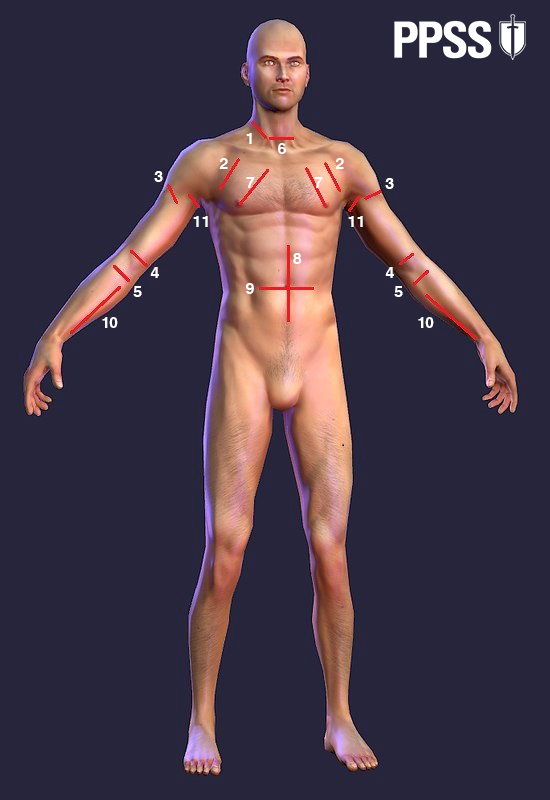
On Monday morning, the 18th April 2018, a 8 year-old boy left home with a kitchen knife and walked into his central Minnesota elementary school. Minutes later he slashed three fellow pupils aged 8, 9 and 13 years-old, all of which requiring surgery.
One doesn’t require intense knife training to cause damage to others, and that you, as a homeland security professional or enforcement agent, must subsequently accept that anyone carrying a knife represents a real danger, even if he/she looks like he/she hasn’t got a clue what he/she is actually doing.
Slash resistant clothing has been developed to effectively improve your personal safety, by offering cut/slash protection to highly vulnerable areas, to which common body armour (bullet or stab resistant vest) do not offer any protection whatsoever. To help you understand why this type of PPE (Personal Protective Equipment) makes real operational sense, please allow me to explain some extremely important things about human anatomy and its relevance to combat… or in this case your defence and survival.
For the purpose of this article I will not go into the ‘stabbing’ motion/action of using a knife. I have extensively covered this in the past and will continue to cover this type of attack in dedicated articles in the future. The following really highlights the potentially irreparable and even deadly consequences of being slashed by either someone who knows what he/she is doing, or by someone who just wildly swings that knife and ultimately may well get ‘lucky’.
I do not claim to be a medical expert, hence please forgive me if something isn’t 100% medically accurate or precise phrased. However, based on my understanding of this subject matter I can assure you that the following information is reliable enough to be taken serious, and for you to either consider issuing your team with slash resistant clothing, or indeed for you to consider wearing it whilst on duty.
Those who know how to use a knife effectively will understand when it comes to knife combat, stabbing and blood loss will not necessarily and quickly incapacitate an attacker. Combat expert and author Michael Janich did an excellent research on this topic, and after careful analysis of forensic data, modern trauma medicine and consulting with experts on this subject matter, Janich’s research concluded the very same.
In fact, in an article titled “The Realities of Knife Stopping Power”, Janich mentioned a case wherein a combatant received 50 stab wounds and still managed to fight for five minutes before collapsing due to collective blood loss, and I personally have witnessed cases of individuals who have survived multiple stabbings and made their way home without any assistance.
In a self-defence situation (or indeed in a situation where your operation requires you to incapacitate an assailant) every single second counts and can indeed make the difference between life and death. If you wound an attacker, but he still has the ability to do the same to you, you may still die.
When/if someone is knowledgeable enough and his intention is to immediately incapacitate you, you really have to understand human anatomy.
To hold anything in your hand, such as a baton, CS gas or shield (if you are a police officer), the muscles of your forearm contract and pull on the flexor tendons, which pass through your wrist and are attached to your fingers. If someone cuts or slashes the tendons or the muscles that power them, this connection is broken and your hand will no longer be able to close or to hold your baton, CS gas, shield or anything else you might be holding.
This concept applies to all muscle groups, tendons and limbs. If someone cuts or slashes the key tissues responsible for you moving a limb, he would most likely disable or at least severely hinder your limb’s function. Sometimes this is referred to as ‘biomechanical cutting’.
Based on the above, your flexors tendons or muscles of the forearm, the biceps and triceps muscles of your upper arms, and the major quadriceps muscles just above the knee require reliable abd effective protection from such deliberate attack or cut.
Just above the knee, where the muscles narrow and connects to the patellar tendon, this area is typically covered by a just single layer of trousers material. It is a comparatively large target, and if someone is close enough to reach your body, that person will clearly also be close enough to reach your quadriceps. Cutting this target is called ‘mobility kill’… you will no longer be able to effectively defend yourself and hence it is extremely likely you will be defeated or eliminated.
Although many will claim that this approach doesn’t work, historical evidence from both sources around the world suggests very differently. Perhaps the best-known reference comes from the Filipino martial arts, which have a very highly evolved edged-weapon culture. Their key tactic is called “defanging the snake”… meaning targeting the attacking limb to destroy its structure and function. According to their symbolism, the weapon is the “fang” and the arm wielding it is the “snake.” Removing the fang from the snake immediately eliminates the primary threat to the defender… the attacker’s weapon.
In the traditional Filipino knife arts, aiming to cut the attacker’s wrist or forearm is one of the prime objectives. The goal is to sever the flexor tendons that connect the forearm muscles to the fingers, destroying the attacker’s ability to grip his weapon. Cutting the muscles on the inside of the forearm can produce the same effect.
Can you slowly see what I can see? Can you see the risks involved when confronted by someone wielding a knife? Most of us are concerned about being ‘stabbed’, but many trained specialists might have other plans… and that’s when slash resistant clothing starts making sense.
The below graphic and following bullet points will give you a reasonable understanding of the most vulnerable ‘slashing targets’. Each ‘successful’ cut or slash can or will either lead to rapid blood loss and subsequent death (most likely caused by a) shock and b) blood loss, or dramatically decrease your mobility. However, please note below graphic does not feature all targets, but is simply a selection of some of the key targets of the front of a human torso. Targets trained professional will aim for to cause maximum harm, pain or death.
Due to the ‘worst case scenario outcome’ we strongly advice to look or re-look at the potential use of slash resistant clothing within your line of work.

- The side of the neck and throat just about even with the adam’s apple. This area contains the Carotid Artery and Jugular Vein. If either is cut the attacker will bleed to death very rapidly. The Carotid is approximately 1.5″ below the surface of the skin, and if severed unconsciousness will result in approximately 5-15 seconds.
- A powerful cut to the outer side of the pectoral muscle can potentially sever the cephalic vein which will bleed profusely.
- A powerful cut across the front of the deltoid muscle may sever the cephalic vein.
- A slashing cut across the biceps can a) disable any motion of the arm and b) as it contains multiple veins it can cause rapid blood loss.
- A slashing cut across the inside of the elbow joint. In addition to the numerous veins, this area also contains the ligaments that enable motion in the forearm.
- A horizontal cut across the neck and throat will not only sever your Jugular Vein and cause death, but it will also cut the trachea and ligaments that control movement of the head.
- A powerful slash across your pectoral muscle will destroy your ability to throw punches with any power.
- A powerful vertical slash, leading to the penetration of the abdominal wall will result in loss of motion, and possible disembowelment.
- A powerfulhorizontal slash to the abdomen leading to the successful penetration of the abdominal wall will result in loss of motion, and possible disembowelment.
- A more than one-inch penetrating slash to the inside of the forearm between the radius and ulna bones will sever the radial artery (this artery runs across the top of the radius bone 2-4 inches behind the base of your thumb). is. Severing the radial artery can result in unconsciousness in as little as 30 seconds, and death in as little as two minutes.
- The brachial artery run along the inside of your arms. This artery is deep, but severing it will result in unconsciousness in as little as 15 seconds, and death in as little as 90 seconds.
All of the potential injuries following any of the above highlighted cuts could be prevented.
I haven’t written this brief article as a scaremongering tactic.
I haven’t written this brief article to provide those bad men/women who currently plan attacks on other good human beings with additional information to cause further harm or harm in a more effective fashion.
There are men and women out there who have made a professional choice in their lives to protect other human beings, facilities, venues, events and infrastructure from the bad guys. We at PPSS Group genuinely believe those men and women have the moral and legal right to be equipped appropriately, and this brief article simply highlights the risks and threat they face sometimes on a daily basis. Risks and threats the general public is not aware of or simply cannot see or comprehend.
Ryan Vickers, PPSS Group’s Director of Global Development, and a man who spent nearly 15 years advising clients on security and risk in hostile and austere environments, says “it is imperative that companies, and their management teams, have an overall process of risk identification, risk analysis and risk evaluation, forming part of a dynamic and up to date risk assessment. Once all the risks have been identified and evaluated, control measures and ‘treatment’ must be put in place in order to keep the residual risk as low as possible. Senior and Operational Management teams within companies have a legal obligation to ensure their staff and teams are provided with adequate equipment and measures. The Context and Risk Assessment forms the base for all operational concepts and decision making.”
Please view the following brief video of Craig Wylde, a close friend of mine, who served as Infantry soldier in the British Army and later was brutally assaulted when serving as a prison officer at Frankland High Security Prison:
We are extremely passionate about their safety and our mission is to let the world know that their safety can be improved dramatically, without compromising their ability to operate and function effectively.
The question simply is do you care enough?
About the Author
Robert Kaiser, is the CEO of PPSS Group, the company behind the global leader in slash resistant clothing: SlashPRO®





